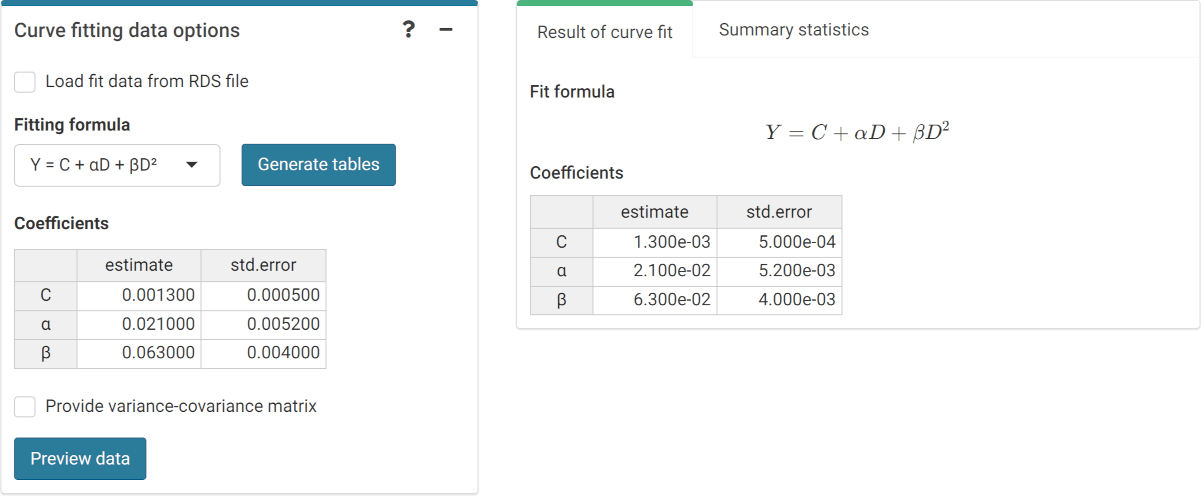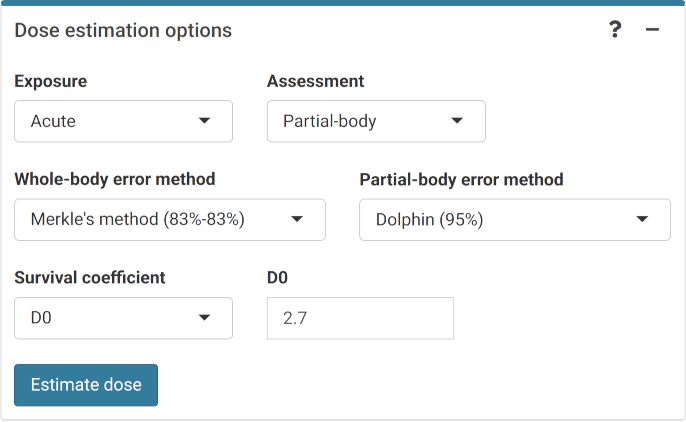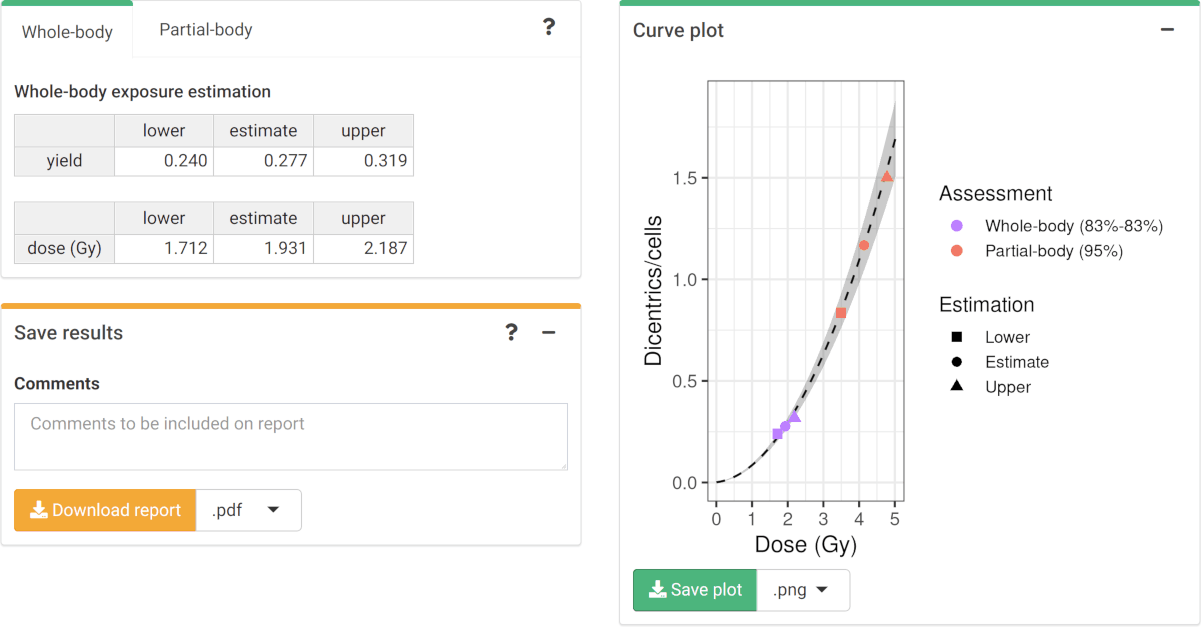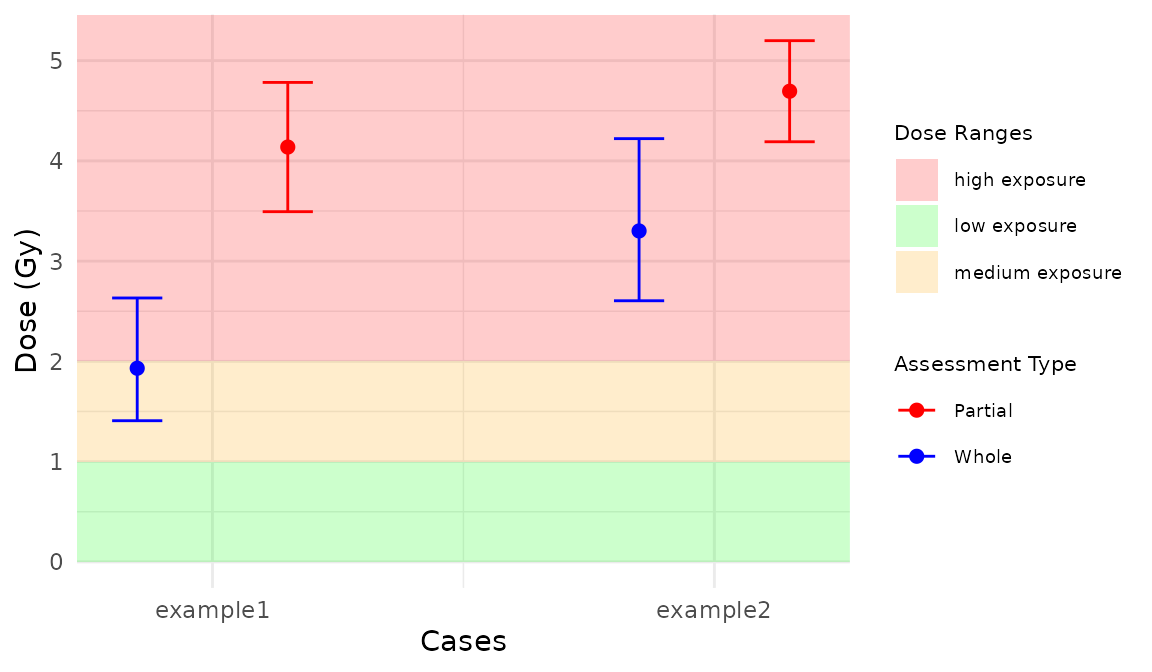Load pre-calculated curve
The first step is to either load the pre-calculated curve in
.rds format obtained in the dose-effect fitting module or
input the curve coefficients manually in case the user wants to use a
pre-existing curve calculated outside of Biodose Tools. Clicking on
“Preview data” will load the curve into the app and display it on the
“Results” tabbed box. If coefficients are entered manually, a
irradiation conditions tab will appear to fill with corresponding
information.

‘Curve fitting data options’ box and ‘Results’ tabbed box in the dose
estimation module when loading curve from an .rds file.

‘Curve fitting data options’ box and ‘Results’ tabbed box in the dose estimation module when inputting curve coefficients manually. Note that if no variance-covariance matrix is provided, only the variances calculated from the coefficients’ standard errors will be used in calculations.
This step is accomplished in R by either using the results from
fit() or by loading an existing .rds object
via readRDS():
fit_results <- system.file("extdata", "dicentrics-fitting-results.rds", package = "biodosetools") %>%
readRDS()
fit_results$fit_coeffs
#> estimate std.error statistic p.value
#> coeff_C 0.001280319 0.0004714055 2.715961 6.608367e-03
#> coeff_alpha 0.021038724 0.0051576170 4.079156 4.519949e-05
#> coeff_beta 0.063032534 0.0040073856 15.729091 9.557291e-56Input case data
Next we can choose to either load the case data from a file
(supported formats are .csv, .dat, and
.txt) or to input the data manually. Once the table is
generated and filled, the “Calculate parameters” button will calculate
the total number of cells
(),
total number of aberrations
(),
as well as mean
(),
standard error
(),
dispersion index
(),
and
-value.
An ID column will also appear to identify each case. Multiple cases are
supported.

‘Data input options’ and ‘Data input’ boxes in the dose estimation module.
This step is accomplished in R by calling the
calculate_aberr_table() function:
case_data <- system.file("extdata", "cases-data-partial.csv", package = "biodosetools") %>%
utils::read.csv(header = TRUE) %>%
calculate_aberr_table(
type = "case",
assessment_u = 1,
aberr_module = "dicentrics"
)
case_data
#> # A tibble: 2 × 13
#> ID N X C0 C1 C2 C3 C4 C5 y y_err DI u
#> <chr> <int> <int> <int> <int> <int> <int> <int> <int> <dbl> <dbl> <dbl> <dbl>
#> 1 exam… 361 100 302 28 22 8 1 0 0.277 0.0368 1.77 10.4
#> 2 exam… 264 200 160 55 19 17 9 4 0.758 0.0736 1.89 10.2Perform dose estimation
The final step is to select the dose estimation options. In the “Dose estimation options” box we can select type of exposure (acute, protracted, and highly protracted), type of assessment (whole-body, partial-body, or heterogeneous), and error methods for each type of assessment.

‘Dose estimation options’ box in the dose estimation module.

‘Results’ tabbed box, ‘Curve plot’ and ‘Save results’ boxes in the dose estimation module.
To perform the dose estimation in R we can call the adequate
estimate_*() functions. In this example, we will use
estimate_whole_body_merkle() and
estimate_partial_body_dolphin(). First of all, however, we
will need to load the fit coefficients and variance-covariance
matrix:
fit_coeffs <- fit_results[["fit_coeffs"]]
fit_var_cov_mat <- fit_results[["fit_var_cov_mat"]]After that is done, we can simply call
estimate_whole_body_merkle() and
estimate_partial_body_dolphin():
results_whole_merkle <- estimate_whole_body_merkle(
num_cases = 2,
case_data,
fit_coeffs,
fit_var_cov_mat,
conf_int_yield = 0.95,
conf_int_curve = 0.95,
protracted_g_value = 1,
aberr_module = "dicentrics"
)
#Parse results for multiple cases
est_doses_whole <- list()
for (i in seq_along(results_whole_merkle)) {
est_doses_whole[[i]] <- results_whole_merkle[[i]][["est_doses"]]
}
est_doses_whole <- do.call(rbind, est_doses_whole)
est_doses_whole <- cbind(ID = case_data$ID, est_doses_whole)
results_partial <- estimate_partial_body_dolphin(
num_cases = 2,
case_data,
fit_coeffs,
fit_var_cov_mat,
conf_int = 0.95,
gamma = 1 / 2.7,
aberr_module = "dicentrics"
)
#Parse results for multiple cases
est_doses_partial <- list()
for (i in seq_along(results_partial)) {
est_doses_partial[[i]] <- results_partial[[i]][["est_doses"]]
}
est_doses_partial <- do.call(rbind, est_doses_partial)
est_doses_partial <- cbind(ID = case_data$ID, est_doses_partial)To visualise the estimated doses, we call the
plot_estimated_dose_curve() function:
plot_triage(
num_cases = 2,
est_doses_whole,
est_doses_partial,
assessment = "partial",
place = "UI"
) 
Plot of estimated doses generated by {biodosetools}. The grey shading indicates the uncertainties associated with the calibration curve.
